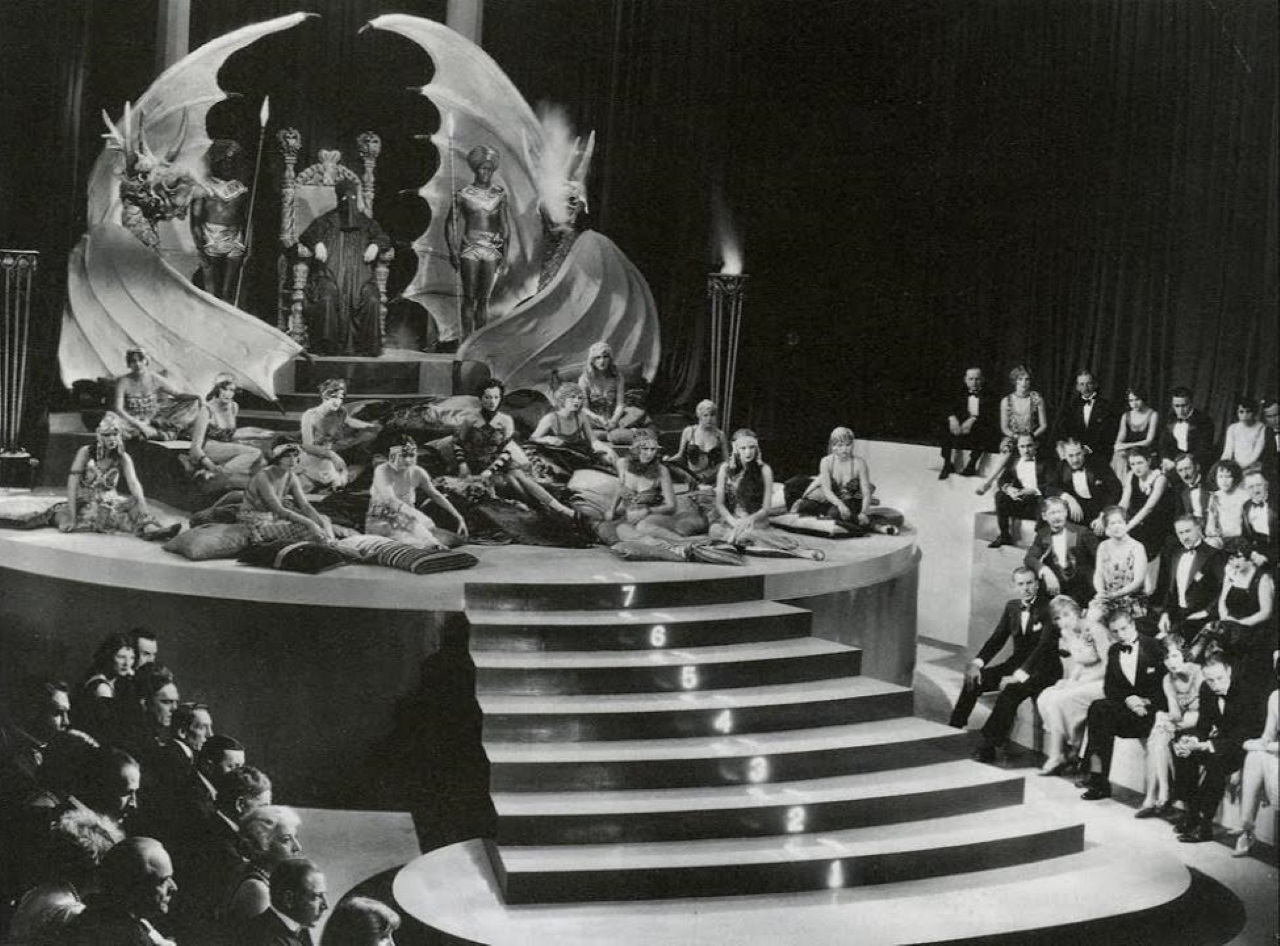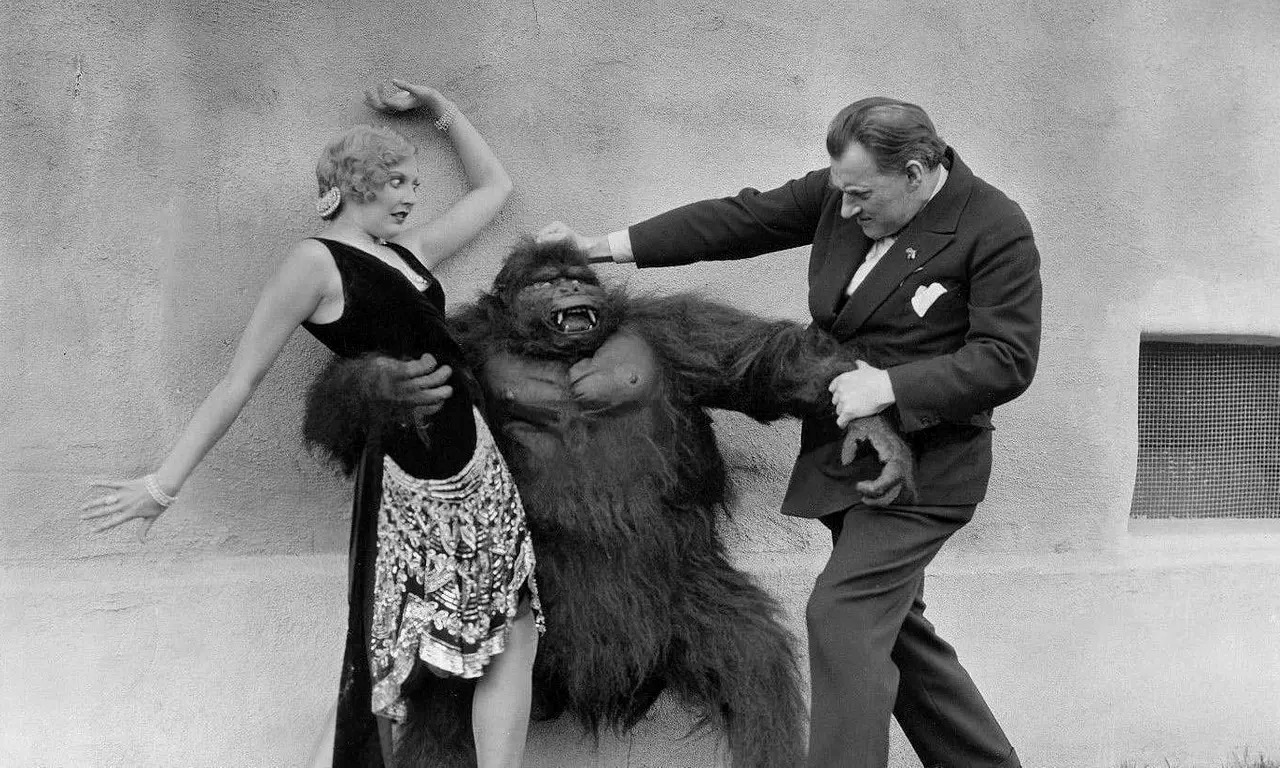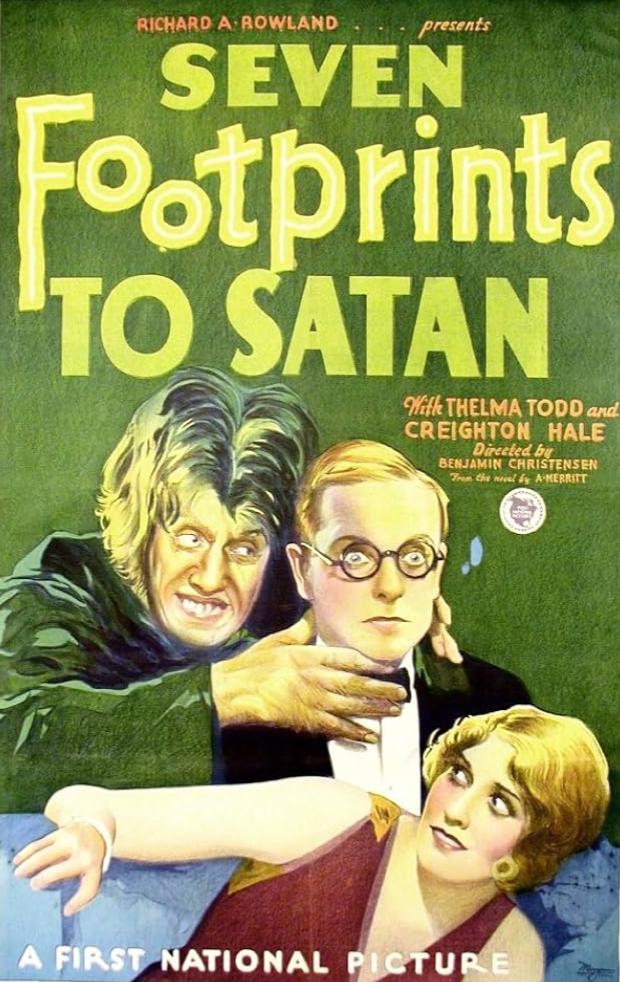Crew
Director – Benjamin Christensen, Screenplay – Richard Bee [Benjamin Christensen], Based on the Novel Seven Footprints to Satan (1927) by A. Merritt, Producer – Wid Gunning, Photography (b&w) – Sol Polito. Production Company – First National.
Cast
Creighton Hale (James Kirkwell), Thelma Todd (Eva Martin), William V. Mong (No 13/Professor Moriarty), Sojin (Sojin), Angelo Rossitto (The Dwarf), DeWitt Jennings (Uncle Joe), Laska Winter (Satan’s Mistress), Sheldon Lewis (The Spider), Ivan Christy (Valet), Kalla Pasha (Professor Werde)
Plot
James Kirkwell has inherited a substantial estate after his parents’ death. He tells his Uncle Joe that he is intending to travel to Darkest Africa in search of adventure. He and his fiancee Eva Martin attend a society ball but this is interrupted as people enter and begin shooting. Fleeing with his chauffeur, James and Eva find that the windows of the car have been replaced with steel shutters. They are taken to a mansion filled with strange people where they are told that they are now prisoners of Satan and may not leave. Trying to make an escape, they pass through the strange rituals that take place in the mansion, encountering bizarre and threatening figures. Satan, the mysterious master of the house, then makes the announcement that he wants to claim Eva as his own.
Abraham Merritt (1884-1943), always listed as A. Merritt on his books, was a newspaper writer and editor who wrote a number of horror and fantasy books and short stories through the 1920s and 1930s. Although Merritt is not read that much today, he gained some modest acclaim during his lifetime and much posthumous critical appreciation. (The texts of most of his works can be found online). During his lifetime, Merritt produced books such as The Moon Pool (1919), The Metal Monster (1920), The Ship of Ishtar (1924), Burn Witch Burn (1932) and The Dwellers in the Mirage (1932). A contemporary of H.P. Lovecraft and Robert E. Howard, Merritt’s work centres around themes that were typical of the fantasy and horror of the era such as lost worlds and civilisations, monstrous entities encountered in unexplored areas of the world, demonic figures and ancient gods. These are conveyed with considerable imaginative flair. The only other film adapted from Merritt’s work has been the Tod Browning film The Devil-Doll (1936), which was based on Burn Witch Burn but threw out almost all semblance to the book.
This adaptation of Merritt’s Seven Footprints to Satan (1927) was conducted by Benjamin Christensen (1879-1959). The Danish Christensen had gained a great deal of acclaim and controversy with his witchcraft documentary Häxan (1922). On the basis of this, Christensen was brought to the US where he made several films at MGM, including working on the silent version of Jules Verne’s The Mysterious Island (1929) but being removed from the final print without credit. At Warner Brothers, Christensen made three Old Dark House films with The Haunted House (1928), Seven Footprints to Satan here and The House of Horror (1929), after which he returned to Denmark and did not direct another film for many years. Seven Footprints to Satan was regarded as a lost film until a print turned up in the last few years.
Seven Footprints to Satan is best placed in the context of a film like The Cat and the Canary (1927). The Cat and the Canary and a host of other film from around this period – see the likes of The Unholy Three (1925), The Bat (1926), The Gorilla (1927), The Unknown Terror (1927), The Terror (1928) and The Bat Whispers (1930), all of which were drawn from Broadway plays. These usually featured heroines in old dark house facing menacing criminals in disguise, combining thrills, some scary elements and an absurdly improbable whodunnit ending. This is something this author has termed the Old Dark House Thriller.

Although it dispenses with many of the conventions of the genre, Seven Footprints to Satan has clearly been intended in the same vein, most notably in starring Creighton Hale, the romantic male lead of The Cat and the Canary, who is essentially cast as the equivalent of Laura LaPlante’s heiress. (Hale is also made up to resemble Harold Lloyd, although makes for rather wimpy leading man today).
The film starts with a banal and unexceptional, even dull, ordinariness. We are introduced to heir Creighton Hale, announcing his plans to go to Africa in search of adventure, the arrival of his uncle (DeWitt Jennings) before he and his fiancee (Thelma Todd) depart for a society function. There is nothing particularly standout about any of these scenes. Things then start to get strange. After exposing a professor passing off a faked jewel, armed people break into the ball. Creighton Hall and Thelma Todd flee with his chauffeur, only for metal shutters to come down across the windows of the car. They are taken to a mansion and ordered to go up to their room.
Whatever is going on at the house appears increasingly stranger – a dwarf appears out of secret panels in the wall warning them to “beware the man with crutches”, they are directed by a sophisticatedly aloof woman who is then seen talking to a giant silhouetted figure around the corner. When they ask how long they are to be there, they are told in title card: “One month … one week … Satan will decide.” Not long after, a woman enters their room begging their help: “Save me. I am to be flogged one hundred times per Satan’s orders,” and later we see glimpses of that happening. There is a severe faced woman who announces “I am Satan’s mistress”; a lurking gorilla who makes up the bed; a professor who has whiskers covering half his face that makes him look like a werewolf; a hand that appears out of the transom over the door and when opened turns out to be an emaciated man who says he has been kept prisoner there for a year without food or water.

In no time, Benjamin Christensen has taken us from polite society and propelled us into a world that is less like an Old Dark House film than a Halloween haunted house where everywhere seems to lurks with sinister figures muttering portentous threats, strange people, pop-up doors and panels, guns poking between the books in a library. The world that Christensen absorbs us into is an entirely fantastical one. The film arrives at the particularly suspenseful scene where Creighton Hale must climb the titular seven steps and chose which three are the rights ones in order to win his fiancee’s freedom.
The great disappointment of Seven Footprints to Satan is that it opts for a mundane resolution. This was very common for the era in The Cat and the Canary and other works such as The Cabinet of Dr Caligari (1919), London After Midnight (1927) and The Beast with Five Fingers (1946) where events that appeared sinister or supernatural in origin would through an absurdly improbable end revelation be revealed to usually be a set-up to drive someone crazy or expose a criminal.
Here [PLOT SPOILERS] we get one of the most ridiculous of these twist ending where it is revealed that everything has been set up by Creighton Hale’s uncle in order to teach him responsibility instead of chasing after adventure in Africa. The three years servitude he has agreed to give Satan transpire as him having agreed to work in his uncle’s firm for that period. Aside from the absurd contrivation of this revelation, the inherent conservatism of it is annoying – one that devalues the aspiration to seek something other than the ordinary; indeed, where adventure-seeking is equated with The Devil and by implication the settled down, responsible working life (even when it is someone who, from the looks of the estate they have inherited, need never work again) is equated with good.
Seven Footprints to Satan was one of the few films to mention The Devil or Devil worship up until the 1960s and Rosemary’s Baby (1968). There was the subsequent Val Lewton film The Seventh Victim (1943) but that suffered from censorship problems, as had Christensen’s own Haxan. The problem with the film here is that you are never sure if it is referring to Satan as in devil worship or that this is simply an honorific that has been granted to the mysterious master of the house.


